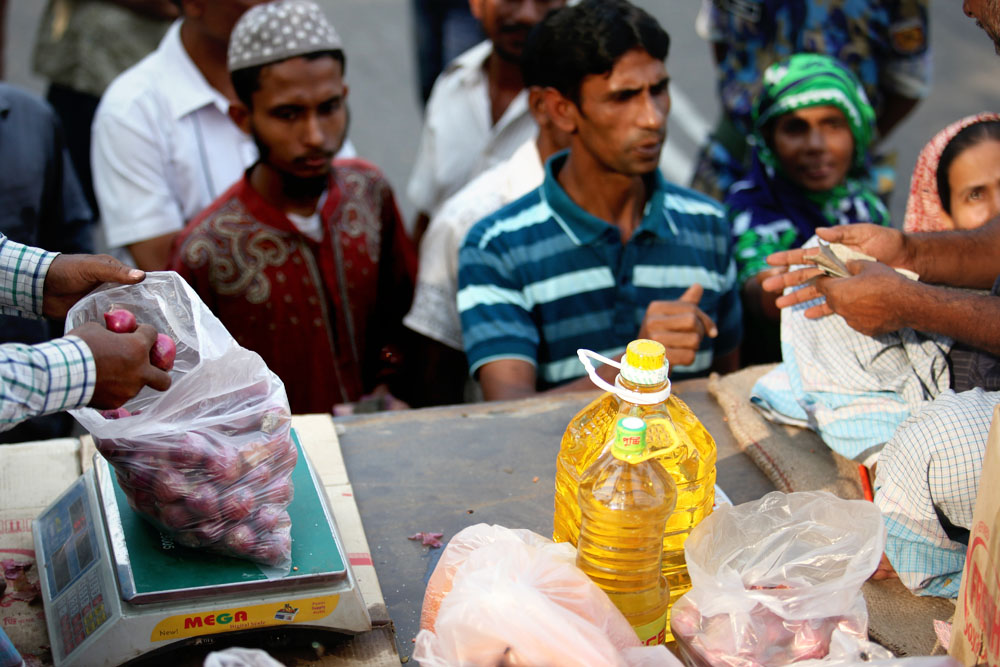Inflation in Bangladesh has dropped from 7.5 percent in January to 7.44 percent in February. This has almost been greeted by a sigh of relief by the Bangladesh Bank as the inflation rate has been rising since October 2013. Media reports also reflected the same mood. One leading national daily headlined, “Inflation reverses upward trend”.
Generally, falling inflation is welcome news. Lower inflation is supposed to be good for the poor and business confidence. But the devil is in the details. Before unpacking, however, it is essential to clear some conceptual issues.
First, inflation measures the rate at which prices are rising. So when the inflation rate declines, it does not mean prices are falling; it means prices are rising, but at a slower rate. Therefore, when the inflation rate falls, one should not be expecting to pay lower price.
Second, inflation is calculated by taking the average of rates of increase of prices of goods and services in the consumption basket of a typical consumer. The basket is divided into food and non-food items. Therefore, the inflation rate will be determined by the rate of increase of food and non-food prices and the proportions an average consumer spends on these items.
 The February inflation rate has declined despite the rise in prices of food items. This has happened because prices of non-food items rose at a much slower rate than the prices of food items. Non-food prices rose by 5.37 percent in February compared to 5.53 percent in January. On the other hand, food prices increased by 8.84 percent cent in February, up from 8.81 percent in January.
The February inflation rate has declined despite the rise in prices of food items. This has happened because prices of non-food items rose at a much slower rate than the prices of food items. Non-food prices rose by 5.37 percent in February compared to 5.53 percent in January. On the other hand, food prices increased by 8.84 percent cent in February, up from 8.81 percent in January.
So, the news of inflation reversing the rising trend since October 2013 will not necessarily bring joy to the poor. As food items heavily dominate their consumption basket, rising food inflation harms the poor most. Prices of rice, lentils, flour, milk and egg all shot up in February. This is also true for the rural dwellers since more than 60 percent of their expenditure is on food items.
It is claimed that cautious monetary policy of the Bangladesh Bank helped reduce non-food inflation. Food price inflation generally does not respond to monetary policy; it is determined by supply side factors as well as import prices. Tighter monetary policy tames the rate of increase of non-food prices (non-food inflation) by reducing demand for non-food items.
The decrease in demand for non-food items means lower demand for workers. This means low paid unskilled workers would be the first to lose jobs if their employers cannot sell the products they produce. As unemployment rises, wages fall too – low paid unskilled workers have to compete among themselves by accepting lower wages to hang onto their jobs or to find one.
So this means the poor and low-income people are doubly affected – they have to spend more on food at a time when they lose jobs and receive lower wages.
The Bangladesh Bank thinks it would be challenging to keep inflation at the target of 7 percent if government borrowing exceeds the target set in the budget. Limiting government borrowing from the banking sector would allow expansion of credit to the private sector.
But there are other issues that need to be looked at. First, while the reduction in government borrowing should leave more funds for the private sector, there is no guarantee that the private sector would like to borrow more. Why should they borrow more when their profitability is affected due to, for example, poor road conditions or frequent power outages?
This brings me to the issue of the purpose of government borrowing. If the government is borrowing to build and repair roads or to build power plants, it should not necessarily lead to lower private investment or higher inflation. As public investment in infrastructure, health and education or social protection improves productivity, private sector may in fact thrive and inflation is likely to fall.
Therefore, in addition to examining the underlying causes of inflation, policymakers need to look at where the government is spending the borrowed money.
————————–
Anis Chowdhury is a former professor of Economics, University of Western Sydney, Australia.
Source: bdnews24










